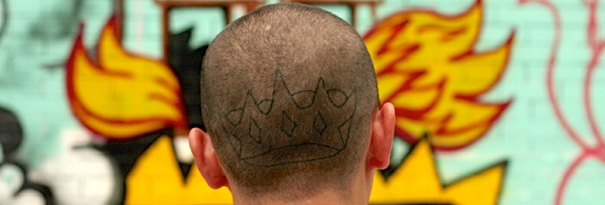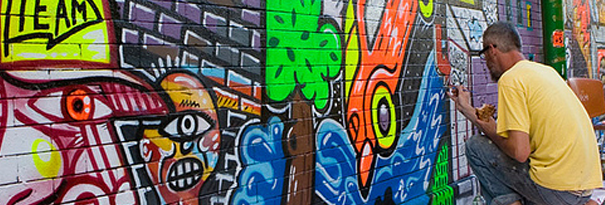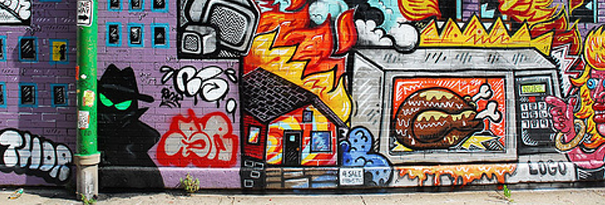Bridgeport is supposed to be the community of tomorrow. A mural painted on the wall of a local gallery tells a slightly different story.
“Get those colors the fuck off that wall! You wanna do something there? Use black and gold, only!” narrates artist Nicky Dieter, in his best gang-impersonation voice, describing the community’s initial reaction to the mural, he, another artist named Thor and a handful of friends painted in four days in the Southside ‘hood of Bridgeport.
Scenesters are predicting a Wicker Park-type gentrification in the area, with the gallery the mural rests upon, the 5,000-square-foot Co-Prosperity Sphere, as the seed of attraction. To the 33rd division of the Latin King set, though, the area is still very much headquarters—as demonstrated by Dieter’s first-hand tales of car windows smashed by bricks and drivers dragged to the asphalt and beaten.
Dieter and Thor, both veteran graffiti writers in the city, subjected themselves to the madness simply because a “dude”—Ed Marszewski, the owner of the gallery—”gave me a wall,” Thor explains, “And whatever I can paint, at this point, I will paint.”
While this comment is mainly a reflection of where the artist is at in his own career (Thor showcases just a few gallery pieces a summer, as he spends most of his time with his family on a farm in southern Michigan), it’s also a stab at Mayor Daley’s ominous Graffiti Blasters crew, which, with the help of an annual $6.5 million budget, erases graffiti within less than 24 hours of receiving a complaint. Dieter chimes in, “When the [Blasters] came, it took away what other cities have. You go to almost any other city and you can see who started their scene, how it developed. And in Chicago, our history is erased. Young kids coming up have no clue what’s done.”
So the Bridgeport mural was a tribute to the art form Dieter and Thor fell in love with as kids. And since they had no plan of attack going in, their wall was bound to be influenced by its surroundings—gang happenings included. “We walked into shocking hostility, that compounded by the falling economy, and our own independent struggles, we saw destruction, felt hate, and created this,” shares Dieter.
“This,” in full horizontal glory, is their depiction of the decline of Western civilization, where a materialistic, severely impatient woman decides to microwave a full turkey out of convenience, but instead sets a neighborhood ablaze. Cars are crashing into fire hydrants. Residents are screaming from their windows, while on the opposite side of the mural, some figures are infatuated with how many logos and brands their clothing can broadcast, and a man lusts for his stock quotes, experiencing life through his computer.
Dieter explains, “The wall’s a comment in general. There’s an ongoing joke that Bridgeport is the community of tomorrow. And we were just making fun of that because it’s been a community that’s been left behind. And I think that’s another reason why we painted an image that’s not friendly, and not lovely. While it looks great, it’s a violent, sad thing that’s happening. This neighborhood was left behind by Mayor Daley and everyone else that used to live here. And they haven’t done anything. I’ve had multiple police officers and people tell me to watch myself when I’m here, because the police officers themselves allow everyone to do what they want.”
Over the course of the four days it took Dieter, Thor and their crew (taggers named Ship, BR and Yoink) to create the mural, gang members and other locals warmed up to them, sharing food, offering beers and insisting that their names be included in the piece. “Most of them were good people,” explains Dieter, “And while anyone should have the right to go into someone else’s neighborhood, you should be respect[ful] of where you’re at.”
To pay its respects, the crew dedicated the core of the piece—a drainage pipe painted to look like a light pole, complete with miniature signs—to the surrounding streets. “The pole is their pole,” says Dieter. “We allowed them to throw up any name that they have, or affiliation, as long as it wasn’t negative.” Names like ‘Mi33y’ (spelled with two threes to signify that she’s from the 33rd district of the Latin King Nation) and ‘Kriminal’ (etched in impressive Old English) can be found among the tags.
Branching out from the light pole, Thor decided to paint the shadow of a classic ‘lurker’ figure, which kids in the community took an odd liking to. “They’d come up and be like, ‘oh, that’s me. I’m the lurker. That’s my personality. I watch what goes on here. I’m a criminal. I do bad stuff, and no one sees me’,” impersonates Dieter. “On the other side of the pole we painted one of the police cameras that has the flashing blue light on it. The camera lens is an eye, the all-seeing eye that watches everything. However, the lurker is on the other side of the pole. And while the neighborhood knows where the camera is, the camera doesn’t know where everything else is, including the lurker.”
At the end of the four days, Dieter and crew began picking up spray-paint cans, and other bits of trash, when they noticed a gang member following suit and sweeping the Latin King side of the street clean. “I asked him for his broom and I swept up our side, as well. When it was done, it was immaculate. Broken bottles, fast-food wrappers…not in sight.”
Dieter and I visit the spot three weeks out from that moment, arms folded in silence as we eye the mural. The Co-Prosperity Sphere swings its doors open, out of the corner of our eyes, for another free evening showcase, when Dieter dictates, “It’s obvious that gentrification happens in this process. Artists move in for cheap rent. Locals are pushed into corners. And it either gets cooler or safer, and all the people that have nothing to do with the art or culture start moving in and ruin it.
“That said, I hope [Bridgeport] doesn’t change. The main thing we were trying to do, when we got this spot, was give a big piece of art to this neighborhood. It’s not an advertisement. It’s something to look at, and it’s offering you nothing. And every local that came and watched us paint, I think saw that.”




